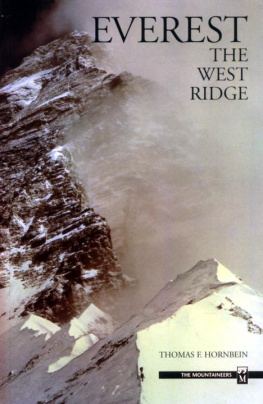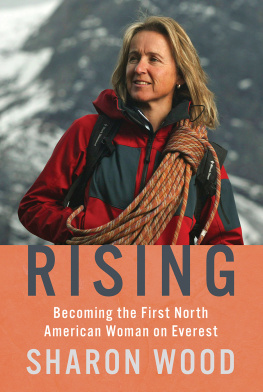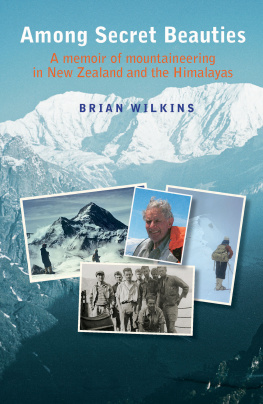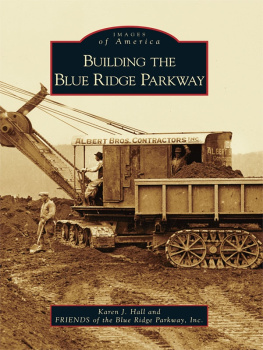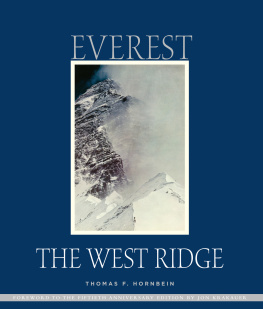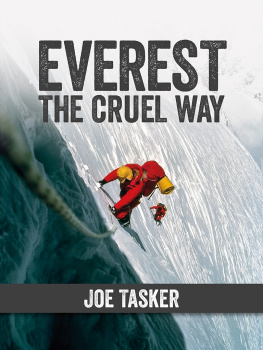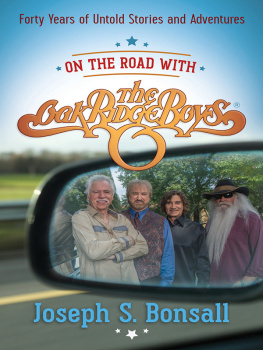Thomas F. Hornbein - Everest: The West Ridge
Here you can read online Thomas F. Hornbein - Everest: The West Ridge full text of the book (entire story) in english for free. Download pdf and epub, get meaning, cover and reviews about this ebook. year: 1998, publisher: Mountaineers Books, genre: Romance novel. Description of the work, (preface) as well as reviews are available. Best literature library LitArk.com created for fans of good reading and offers a wide selection of genres:
Romance novel
Science fiction
Adventure
Detective
Science
History
Home and family
Prose
Art
Politics
Computer
Non-fiction
Religion
Business
Children
Humor
Choose a favorite category and find really read worthwhile books. Enjoy immersion in the world of imagination, feel the emotions of the characters or learn something new for yourself, make an fascinating discovery.
- Book:Everest: The West Ridge
- Author:
- Publisher:Mountaineers Books
- Genre:
- Year:1998
- Rating:4 / 5
- Favourites:Add to favourites
- Your mark:
- 80
- 1
- 2
- 3
- 4
- 5
Everest: The West Ridge: summary, description and annotation
We offer to read an annotation, description, summary or preface (depends on what the author of the book "Everest: The West Ridge" wrote himself). If you haven't found the necessary information about the book — write in the comments, we will try to find it.
Everest: The West Ridge — read online for free the complete book (whole text) full work
Below is the text of the book, divided by pages. System saving the place of the last page read, allows you to conveniently read the book "Everest: The West Ridge" online for free, without having to search again every time where you left off. Put a bookmark, and you can go to the page where you finished reading at any time.
Font size:
Interval:
Bookmark:

EVEREST
The West Ridge
By THOMAS E HORNBEINFOREWORD BY DOUG SCOTT




To all of us who knew Willi and Dick, with love.
Contents
v
x
25 31 43 49 57 63 75 81 84 100 119 131 143 158 168 177... Everest rises, not so much a peak as a prodigious mountain mass. There is no complication for the eye. The highest of the world's great mountains, it seems, has to make but a single gesture of magnificence to be lord of all, vast in unchallenged and isolated supremacy. To the discerning eye, other mountains are visible, giants between twenty-three and twenty-six thousand feet high. Not one of their slenderer heads even reaches their chief's shoulder; beside Everest they escape notice: such is the pre-eminence of the greatest.-GEORGE LEIGH MALLORYForeword
In 1920, Sir Charles Bell, the British Resident in Lhasa, received the first permission for climbers to visit Mount Everest. In the intervening six decades, several thousand men and women have set foot on the mountain, and just over one hundred of them have reached its summit. Over the years the style of climbing has "progressed" on Everest just as on lower mountains. Climbing is seen to evolve wherever more difficult routes are attempted, and whenever climbers climb these routes in a more adventurous style, as for example in smaller groups and with less equipment. On Everest the emphasis until recently has been less on style than on pioneering new routes.
There are now routes via the South Col, the West Ridge, the North Col, the Southwest Face, and the West Ridge Direct. These, however, were not necessarily ascended in order of difficulty, for on Everest, straddling the Tibetan-Nepalese border, international politics often determined which routes were accessible at any particular time.
Interesting lines remain, mostly on the Tibetan side of the border: the Northeast Ridge, the Kangshung Face and the Northwest Face. Several parties have considered the somewhat amorphous South Buttress that bounds the Southwest Face on its right, but so far no serious attempt has been made. There is obviously room on Everest to pioneer new and more difficult routes.
The evolution encompasses climbing style as well as difficulty. The original South Col route was naturally the first climbed in the premonsoon season, when the weather conditions are relatively favorable. The first postmonsoon ascent of this route was made in late October of 1973 by a Japanese expedition. The first winter ascent has just been accomplished; during January and February of 1980 Polish climbers battled appalling gales and cold until two climbers put in the effort that took them through to the summit and back. The four young climbers who, without any other support, attempted Everest in 1962 (Woodrow Wilson Sayre, Four Against Everest) made a significant contribution to style, although that event was ahead of its time and the participants did not have previous Himalayan experience. Now that other major Himalayan peaks, including K2 and Kangchenjunga, have been safely and successfully climbed in lightweight style with minimum use of fixed ropes and oxygen, the scene is set for alpine or near alpine ascents of Everest.
The first oxygenless ascent via the South Col in 1978 by Messner and Habeler was a big step forward, one that will be to the ultimate benefit of Alpine-style climbing in the Himalaya now it is known that a well-acclimatized person may find the extra weight of the oxygen bottles a burden not offset by their contents. Everest has yet to be climbed without oxygen being used by support parties, and it is likely that climbers will wish to climb new routes without oxygen. It is only a matter of time before a lone climber combines the drive with the skill and endurance to make the first solo ascent of Everest. The evolution of style is the search for new challenges as climbers reach for the limits to which they can go.
In fitting the climbs that have taken place on Everest into the category of difficulty, we are apt to overemphasize present and future achievements and overlook much of that which has been "surpassed." We are also likely to ignore other, less apparent aspects of climbing that are central to this high adventure. For instance, attaining the summit by a new route and in impeccable style is of tremendous importance to sponsors, the leader, the support party, and the successful climbers, as well as to climbers everywhere. But often the summit merely defines a high point on the journey up and down the mountain, where it is the struggle to achieve or merely survive that may be a truer measure of the accomplishment. This struggle does not necessarily take place on the summit, or only during successful attempts.
It is impossible to measure the heroic exertions that have taken place over the years on the flanks of Everest and to suggest that one effort was more heroic than another. Right from the start in the early 1920's a few climbers periodically have found themselves at the limits of what was presumed to be physically, physiologically or psychologically possible. It must have always been pretty much the same limits, the same sort of struggle. The only difference has been one of time and place, for on each occasion that the frontiers of the possible were transcended, the psychological barriers were lowered and climbers pushed on to the next horizon, often aided by improved equipment, strategy, and technique. As measured by actual risk and commitment, there has been no evolution, the spirit of adventure remaining more or less constant over the years and on all sides of the mountain.
In 1963, however, the West Ridge of Everest was climbed by Hornbein and Unsoeld, who then went on to traverse the mountain for the first and only time. This was, on account of the greater commitment demanded of them, an exceptional tour de force and is well described in this book. How does this West Side story fit into the sixty-year history of Everest? On close examination, it moves into a class all its own, for it was here perhaps more than on other climbs that a point of no return was reached, and a total commitment made. On other summit attempts, the climbers knew that in an emergency they had but to retrace their route of ascent back down, often down fixed ropes, to support camps. But when Willi Unsoeld and Tom Hornbein left their top camp, they had to pass over more then 2,000 feet of unknown ground with all the accompanying little worries of where to belay or bivouac, how steep the rock steps were, what the limits of their own powers of endurance were. There was no fixed rope above 25,100 feet and the higher they went the more it became apparent that abseil points were nonexistent, that their only chance lay in "topping out" and climb ing down the Southeast Ridge to the South Col.
When the decision was made (or perhaps made for them?) to go for it. all negative thoughts and feelings stopped. Now that the way was clear, they tapped hidden reservoirs of energy. Now that all backward thoughts had ceased there was "no fear, no worry, no strangeness." Now that the die was cast, they set out along the summit ridge of all Asia down into the night shadows and the terrible cold of a 28,000-foot open bivouac. Here they survived, caring not only for each other, but also for two exhausted colleagues. These were exceptional men.
Next pageFont size:
Interval:
Bookmark:
Similar books «Everest: The West Ridge»
Look at similar books to Everest: The West Ridge. We have selected literature similar in name and meaning in the hope of providing readers with more options to find new, interesting, not yet read works.
Discussion, reviews of the book Everest: The West Ridge and just readers' own opinions. Leave your comments, write what you think about the work, its meaning or the main characters. Specify what exactly you liked and what you didn't like, and why you think so.

